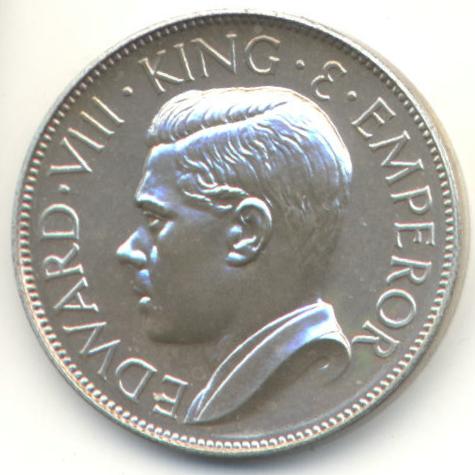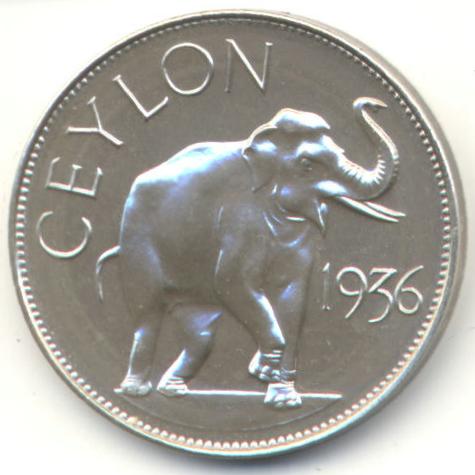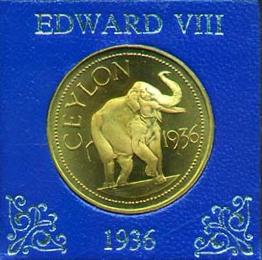| SPECIFICATIONS | |
| Denomination | 1 crown |
| Alloy | Silver (925. Ag) |
| Diameter | 38.6 mm |
| Weight | 28.10 gms |
| Thickness | mm |
| Shape | Round |
| Edge | Plain |
| DieAxis | O° |
| Proof | 100 |
| Prooflike | 500 |


A piece of fantasy struck by the Franklin Mint Ltd without any government authorization for the obvious confusion of the numismatic community. It is attributed as "1954 Geoffrey Hearn Series", in "Unusual World Coins" by Colin R. Bruce II, Iola, Wisconsin, Krause Publication, 1992,
|

|

| ||||||||||||||||||||||
| Bruce # XM1b | ||||||||||||||||||||||||
Obverse : Left facing image of Edward VIII with
EDWARD.VIII.KING.&.EMPEROR along the periphery.
Reverse : CEYLON on left along periphery. A elephant with a trunk raised above the
year 1936.
A series of coins dated 1937 was prepared for issue at the time of Edward VIII expected coronation in May 1937. A very small number of proof sets were produced in UK, containing coins from the gold five pound down to the farthing. Edward VIII broke with the tradition of succeeding monarch's heads facing in opposite directions as he preferred his left profile. Over 200 dies for coins and medals were scrapped when he abdicated on 1936 December 10th in order to marry Wallis Simpson from Baltimore, USA. King Edward VIII coinage dies did not get used for minting apart from several trial and pattern strikes.
The Silver Proof-like coin, enclosed in a circular coin case is embedded in black velvet inside a plain dark blue 7.5cm square spring hinged box.
The coin was scanned at 300dpi and the images are displayed at 165dpi.
I first saw an image of this coin over 30 years ago in a Junior Golden Guide on Coins by Richard L. Leisenring published in 1966 by Dean & Son Ltd. The nature of this coin was explained to me by John M. Kleeberg, the Curator of Modern Coins and Currency, of the American Numismatic Society. This coin was found and purchased on the web from a dealer in Nashville, TN the same month August 1998.
An explanation of the origin of this coin was sent to me by Colin Bruce II, at Krause Publications, "The Ed VIII/Ceylon elephant is purely a fantasy issue. Geoffrey Hearn, (English?), was a collector and decided he would have some additional "coin types" created for King Edward for the colonies that didn't actually have circulating coins produced in his name or in this case crowned sized pieces."
Similer medals were struck for Australia, Bermuda, Great Britain, Haiti and New Zealand. All show the same youthful portraint of Edward VIII facing left on obverse but have a reverse design native to the country. They show a very high relief and are beautiful examples of the engraver's art. Fantasy Coins of this type were produced by
 The Frankling Mint (formely John Pinches Limited)
returned the original punches to Mr Geoffrey Hearn c/o Century
Club, Ryder Street, St. James's London S.W.1. U.K on 2nd June 1977.
Richard
Lobel, of CoinCraft of London bought the dies had more pieces
struck in Europe in 1984. As a slightly larger planchet was used the
lower quality restrike shown on right can be easily recognised from
the original by the rim outside the dotted circle on both
sides. Fantasy proof-like coins in both Silver(250) and Cu-Ni(2500)
representing the 24 British Commonwealth countries :- Great Britain,
Australia, British North Borneo, British East Africa, Bermuda, Burma,
Canada, Ceylon, Cyprus, Gibralta, Gold Coast, Hong Kong, India, Isle
Of Man, Falkland Islands, Mauritius, Newfoundland, New Guinea, New
Zealand, Palestine, Sierra Leone, South Africa, Southern Rhodesia and
Straits Settlements were minted at that restrike.
The Frankling Mint (formely John Pinches Limited)
returned the original punches to Mr Geoffrey Hearn c/o Century
Club, Ryder Street, St. James's London S.W.1. U.K on 2nd June 1977.
Richard
Lobel, of CoinCraft of London bought the dies had more pieces
struck in Europe in 1984. As a slightly larger planchet was used the
lower quality restrike shown on right can be easily recognised from
the original by the rim outside the dotted circle on both
sides. Fantasy proof-like coins in both Silver(250) and Cu-Ni(2500)
representing the 24 British Commonwealth countries :- Great Britain,
Australia, British North Borneo, British East Africa, Bermuda, Burma,
Canada, Ceylon, Cyprus, Gibralta, Gold Coast, Hong Kong, India, Isle
Of Man, Falkland Islands, Mauritius, Newfoundland, New Guinea, New
Zealand, Palestine, Sierra Leone, South Africa, Southern Rhodesia and
Straits Settlements were minted at that restrike.
Restruck again in the 1990's to the original planchet size it is mostly cupro-nickel, but X-ray fluorescence showed Yttrium and Zirconium on the surface of the alloy. This fantasy which is more heavy than the Silver and sometimes gold plated have recently been appearing on ebay auction in large number from International Numismatics in Melbourne, Australia. They were however unable to tell me how many were minted in th 1990's.
"In 1937, the British Royal Mint commenced preparing designs for a new
coinage under Edward VIII. Subsequently, Edward VIII abdicated prior
to his coronation and, though a few coins were produced in his name
(e.g. in British West Africa), most countries abandoned their plans
for such coinage. The designs and partially-finished dies sat in
various archives for many years. The Desaulles portraits of
Edward VIII, both crowned and uncrowned, were acquired in the 1990s by
a British Private Mint, International Numismatic Agency Ltd,
. These
designs and partial dies were re-worked and/or finished, and a limited
edition striking of coins for several colonies and Great Britain was
produced. There were 975 sets of four coins for each country (Ceylon
NOT included): in four metals, silver, brass, Barton's metal and
copper. Following the production of these runs, the dies were destroyed."
I thank Cris Butariu of Accu-Rate coins of Ottawa, Canada for the above
quote
For details of original Patterns please see 1973 article "The proposed coinage of King Edward VIII" by Graham P. Dyer which is printed in the Royal Mint report of 1972.